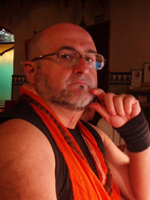As we have seen in an earlier chapter, the yogic breathing along with the inhalation and the exhalation of air, teaches us the importance of retention also. By retaining the air in the inside of the lungs, the exchange of oxygen and carbon dioxide is more intense. In normal conditions when we exhale without retention, an abundant proportion of oxygen remains in the air that was exhaled. This is the reason for example that we can resuscitate someone when we do mouth to mouth. Practised with pauses, the retention of the breath stimulates the cells, the vital functions and produces a certain process of rejuvenation.
The centre of breath control is found in the spinal bulb where all the information received is processed in the whole body. With this information, in a conscious way, we can take control of our breathing and help ourselves to control the sympathetic vegetative system, which organises all the vital functions. We will also control digestion, body heat, excretion and sleep among other functions. Vital energy, Prana, has two basic manifestations, one is what produces the breath and the other is what moves thoughts. Both are intimately connected.
When the breathing is in movement, the mind also is and if the breath is under control, the mind is also under control. When the vital forces of the body are under the control of the creative mind, suddenly one can feel a general increase in energy and sensitivity, the senses become sharper and can work better.
The purpose of Vyayam is to increase breathing capacity and obtain its control. The ancient yogis knew that the secret of health and of the control of the mind was in the breath. For this reason they said that the breath is our eternal companion, and they called the god of the divine breath, Vayu, he who gives the breathing capacity that controls the movement of the mind. They called the breath Vayuka, which means “to have the presence of the god Vayu”. For this reason they considered that the breath was something sacred and that men should live in a pure and divine atmosphere.
There is an energetic heart that pumps energy throughout the body. Its physical projection is located 4 fingers below the belly button and in Sanskrit it is called the tan, literally tan hara shakti. The tan, is a neuralgia point of what is called the belt of strength, tan hara shakti, and is divided into the frontal region known as the tan shakti, and a back region called the tan tala. The tan hara shakti is where all the balance of the body is concentrated and where the mind descends to acquire serenity and rest.
With effective control of the breath through Vyayam, we learn the process of making the vital energy or prana and the subtle energy or shakti, expand from the tan to our body and mind.
® Written by ~ Swami Shankaratilakananda
(All rights reserved by the author
